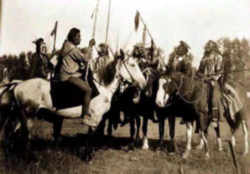


Kansas Early History
First Early Inhabitants of Kansas

Early history examines the archaeological record that tells the story of the first inhabitants of Kansas. Learn about the prehistory and culture of the first early inhabitants, and what lessons it might teach us about the early history of Kansas.
Kansas First Early Inhabitants Timeline
- 300Mil BC - In 2009 researchers in Kansas found the fossilized brain of an iniopterygian fish dating to about this time. The fish is a relative of modern ratfishes, also known as ghost sharks. (SFC, 3/3/09, p.A5)
- 120Mil BC - The middle of what later became the USA was covered by the Niobrara Sea. (SFC, 8/10/00, p.A16)
- 78Mil BC - Fossil bones of a plesiosaur that lived about this time were unearthed at a Kansas ranch in 1968. The 15-foot dinosaur was believed to have given birth to live young under water. (SFC, 8/12/11, p.A6)
- c12000BC - In 2004 archaeologists in Kansas working near the Colorado-Kansas border reported radiocarbon dating results finished in February that showed mammoth and prehistoric camel bones dating back to about this time. (AP, 6/13/05)
- Paleoindian 11,000 BC - 7,OOO BC - The earliest inhabitants of Kansas were descended from Asian immigrants who entered North America by crossing into Alaska.
- Woodland AD 1 - 1000 - The Woodland period was marked by great changes in social systems, subsistence practices, and technology. One of the most notable changes involved the widespread making of pottery vessels. Chipped stone tools continued to be made in a variety of shapes and sizes, but projectile points became smaller as the bow and arrow began to replace the atlatl.
- Village Gardener AD 1000 - 1500 - During this period most of the state's inhabitants shifted to a dual economy, based on bison hunting and the cultivation of corn, squash, and beans, supplemented by small-scale hunting and gathering of wild foods. Use of the bow and arrow became widespread, although the atlatl still saw limited use.
- Protohistoric AD 1500 - 1800 - The Protohistoric refers to the period of time shortly before and after the arrival of Europeans in the New World.
- 1000 and the time of "first contact" - People of Kansas depended upon two main food sources: bison hunting and the cultivation of corn, squash and beans.
- 1541 - Francisco Vasquez de Coronado (1510-1554) explores Kansas
- 1600 - Kansa and Osage Indians arrive in Kansas
1724 1724 - French explorer Etienne Veniard de Bourgmont (1698-1725) claims the region for France
Early History of Native Americans in Kansas
The Indigenous People of Alabama
The names of the Kansas tribes included the Arapaho, Cheyenne, Chippewa, Comanche, Delaware, Kansa, Kiowa, Missouria, Osage, Otoe, Pawnee, Illinois and Iroquois.
Archaeologists tell us that people have been living in the area now known as Kansas since 12,000 BC, during the end of the Ice Age. Huge animals
such as mammoth and mastodon lived in the area until climate change made it too warm for them to survive. It is believed that the first people who
migrated to Kansas were descendents of people from Asia who crossed into North America through Alaska. These people were known as Paleo-Indians and
were nomadic hunter-gatherers. These people hunted the mammoth and mastodon as well as eating berries, seeds, roots, and other small animals. They
used spears tipped with stone points for hunting.
The Archaic Period (7000 BC - 1 AD) began with continued warming of the climate and the ending of the Ice Age. Because the big game they had been hunting
had died out, their diet changed to include more small game, and more plant foods. In order to grow enough food, they became less nomadic, and gradually
established settlements. The people in these settlements began to grind seeds into meal. There is evidence that by about 3500 BC these people began
to make ceramic objects.
The Woodland Period (1 AD - 1000) brought great change to the people living in the area. Use of pottery increased, and hunters began to use bows and
arrows in place of the atlatl (a kind of spear thrower). Toward the end of the period, agriculture began in earnest and the people began to grow corn.
Archaeologists have also found evidence of ceremonial burial and the building of burial mounds.
Between 1000 and the time of "first contact" with white explorers, the people of Kansas depended upon two main food sources: bison hunting and the
cultivation of corn, squash and beans. They also practiced small-scale hunting and gathered wild foods. People lived in rectangular earth lodges in
the northern part of the area; in the south, they built houses covered with thatched grass. The population grew, and people lived in villages. We also
know that the people began to trade more extensively with groups around them, particularly with the Puebloan Indians of the Southwest.
By the time European explorers arrived, we are able to identify the people living in Kansas with tribes such as the Pawnee, Kansa, Wichita, and Apache.
There is evidence of contact between the Indians and Europeans, including fragments of Spanish chain mail armor found among the grass huts of the Wichita
people.
After brief visits by the Spanish explorer, Coronado, in the area, the French arrived around 1750, and formed an alliance with the Kansa Indian tribe.
Europeans were interested in the lucrative fur trade with the native people, and began to travel through the area with more frequency. However, widespread
settlement did not happen until Kansas became a territory in 1854, because prior to that time the state was part of the large area known as "Indian
Territory" where displaced tribes from further east were forced to relocate.





